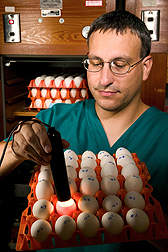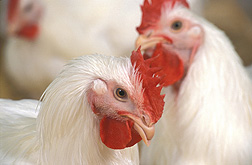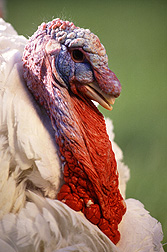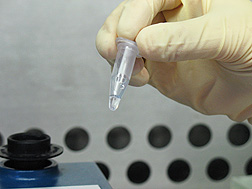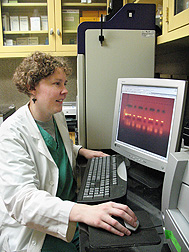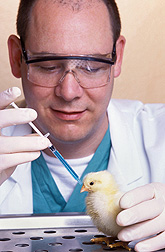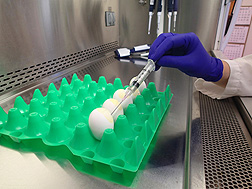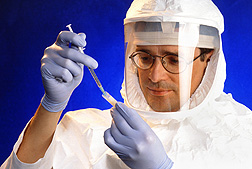Reducing the Threat of Exotic Avian Diseases
|
|
Before media headlines announced outbreaks of a new type of avian influenza virus in China in 2013, Agricultural Research Service scientists were already working day and night to pinpoint crucial information about the H7N9 virus that was affecting humans as well as poultry.
Inside the high-level, secure Southeast Poultry Research Laboratory (SEPRL) in Athens, Georgia, the scientists studied the virus sample received from the Centers for Disease Control and Prevention (CDC). They labored quickly to determine whether the existing genetic diagnostic assays, the real-time reverse transcriptase polymerase chain reaction (rRT-PCR), could identify the virus or needed to be modified first, and whether new ones needed to be developed. They examined the effectiveness of available avian influenza vaccines and began research to develop new vaccines to protect poultry against the virus. And they investigated the virus’s origin to identify the poultry species potentially involved in transmission of the virus in humans and its continuation in China.
This is what the small team, led by David Suarez, research leader of the SEPRL’s Exotic and Emerging Avian Viral Diseases Research Unit, does best. The group responds quickly to emergency needs in foreign or exotic animal diseases. The laboratory serves as an international collaborating center for avian influenza and Newcastle disease with global partners, industry, and U.S. governmental agencies, such as USDA’s Animal and Plant Health Inspection Service and the CDC. Scientists focus on research to help prevent and control diseases such as avian influenza, sometimes called “bird flu,” and Newcastle disease that threaten the poultry industry worldwide.
“Our lab looks at diseases from the poultry angle, but we’re also very concerned about public health,” Suarez says. “We work closely with CDC and the National Institutes of Health to share data and information for both animal and human health.”
|
|
Classifying Avian Influenza Viruses
Avian influenza virus strains, which infect poultry and other bird species, are characterized using two main proteins—hemagglutinin (H) and neuraminidase (N)—located on the surface of the virus, says David Swayne, SEPRL director.
Scientists sequence viruses or run serological tests for the 16 different hemagglutinins and 9 neuraminidases to determine the virus subtype. Some of these proteins are found in influenza viruses that grow in birds, and some are found in mammals and other species. Of the different H subtypes, only H5 and H7 have been found to be highly pathogenic for birds, which means they cause severe disease and kill more than 90 percent of infected birds, Swayne says.
“Highly pathogenic avian influenza viruses cause high poultry death losses, spread rapidly, and result in bans on international trade. They must be eradicated immediately. Low pathogenic viruses cause sick chickens and financial losses for farmers, but we can work with them through improved vaccines and other farm-management tools,” Swayne says.
However, one exception makes research very essential, he adds.
“We want to know if the low pathogenicity virus can mutate to become highly pathogenic, which has happened multiple times,” Swayne says. “That’s the big question.”
“Ducking” Bird Flu
A major concern is the H5N1 highly pathogenic avian influenza virus that continues to circulate in Asia, the Middle East, and Africa, causing great losses in poultry and disease in humans, says veterinary medical officer Mary Pantin-Jackwood.
Domestic ducks, which are common in Southeast Asia, have been implicated in the spread of the H5N1 virus. There, domestic ducks are raised in backyards and in rice paddies, where they can come into contact with wild ducks and other poultry.
“Because of these contacts, domestic ducks are a source of H5N1 and other influenza viruses. They’re like a mixing vessel,” Pantin-Jackwood says. “The influenza virus mutates a lot, but it can also pick up genes from other influenza viruses.”
Ducks infected with H5N1 virus show a wide range of responses—from moderate-to-high mortality to no sickness at all—which makes it difficult to recognize and control H5N1 influenza in these birds. This helps explain why the virus remains endemic in countries like China, Vietnam, and Indonesia, where ducks are a large food industry.
In her studies, Pantin-Jackwood showed that young ducklings do not fight off H5N1infection as well as older ducks.
Successful control of the H5N1 virus in domestic ducks is important for the eradication of the disease in commercial poultry in Southeast Asia, she says. Duck species and husbandry practice should be considered when planning surveillance and control measures in countries with large domestic duck populations.
Pantin-Jackwood examined two commonly farmed domestic duck species, Muscovy and Pekin, and found a big difference in response to infection and vaccination against H5N1. Both species became infected with the virus, but Muscovy ducks developed a more severe disease.
“You need to vaccinate according to species of bird,” she says. “In addition, domestic ducklings should be vaccinated before they are 1 month old and released into rice paddies, so they are well protected.”
|
|
Getting the Most Out of Vaccines
When a highly pathogenic H7N3 virus was reported in Mexico in 2012, microbiologist Darrell Kapczynski examined available vaccines to make sure they would be able to protect U.S. poultry against this virus. He analyzed two USDA-approved H7 isolates and developed inactivated vaccines.
“We demonstrated 100 percent protection in vaccinated birds against a lethal challenge of the virus, showing that the vaccine derived from these isolates could protect U.S. poultry,” Kapczynski says.
Scientists also determined that the new virus was not the same H7N3 virus obtained from ducks in Mexico in 2006. The two viruses were related, but the 2012 virus was not a direct descendant of the 2006 virus, Kapczynski says.
“What is interesting about the 2012 virus is that the genetics that make it highly pathogenic come from the bird itself,” he adds. “This virus mutated using the host’s own nucleic acid—incorporating part of the chicken genome into the virus genome.”
This unusual “genetic recombination” event underscores the need to make sure that poultry are also free of the low pathogenic forms of the virus, he says.
Kapczynski and his colleagues also demonstrated that the Mexican 2006 low pathogenic virus could be used as a vaccine. All birds vaccinated with the virus strain and challenged with the 2012 virus were protected.
“The economic impact of this newer virus is enormous,” he says. “The affected region produces around 55 percent of the table eggs in Mexico. More than $720 million in losses were reported by the industry since the outbreak. Fortunately, the virus hasn’t moved into the United States.”
|
|
Keeping an Eye on Egg Production
The 2009 pandemic H1N1 influenza virus—known as “swine flu”—does not kill birds; it infects the reproductive tract of poultry, causing decreased egg production, Kapczynski says. First identified in Mexico, the virus spread quickly around the world. It was found in swine in Canada and in breeder turkeys in Chile, Canada, and the United States.
“This was a ‘reassortant’ virus, meaning it contains two or more pieces of nucleic acid from different parent viruses,” Kapczynski says. “Typically, influenza viruses segregate based on species they can infect.” This virus had gene segments of avian, human, and swine influenza viruses and was capable of infecting mammals as well as poultry.
The poultry industry wanted to know whether the vaccines in stock would protect turkeys against the 2009 H1N1 influenza virus. Kapczynski and his colleagues made a new vaccine from the pandemic H1N1 virus and tested it against commercial inactivated H1N1 vaccines. Birds were vaccinated either with the pandemic H1N1 vaccine or the commercial vaccines and then challenged in the laboratory. Scientists looked at egg production, serology, and shedding. The new vaccine protected against egg-production losses, whereas the commercial vaccines were not as effective.
“The take-home message was that the turkey industry needed to update the isolates in the vaccines to more closely match the field strains in order to protect their flocks against this virus,” Kapczynski says.
|
|
Taking a “Swab” at Viruses
Before poultry is processed in the United States, the birds must be tested for avian influenza. Sample collection plays a key role in this process.
“In poultry, we test nearly 100 percent of all meat chicken and meat turkey flocks for the virus prior to processing. We also do a lot of surveillance in egg-laying chickens,” says microbiologist Erica Spackman.
Identifying the best methods to collect avian influenza samples for optimal testing, and making sure the process is economically feasible, is important. Although the current method works well, Spackman found that improvements could be made.
“One of the most important variables is the number of swabs required—the sample size we take from inside the mouth of the chicken or turkey to see if the virus is there,” Spackman says. “We need to collect a certain number of swab samples per flock to get a reasonable virus sample.”
Swab samples are collected from the same flock and put into tubes for testing. Traditionally, each tube contains 1-5 swab samples. The idea was to determine whether more swab samples could be pooled together into a single tube without inhibiting or affecting the sensitivity of the test.
Spackman found that putting 1, 5, or 11 swab samples in the same tube did not affect testing. A similar experiment with Newcastle virus samples had the same results.
Industry groups are already using the new process, which saves money without comprising test performance, Spackman says.
|
|
Investigating Newcastle Disease
Exotic Newcastle disease, an extremely virulent form of the virus, is not found in the United States, but it is widespread in Asia, Africa, South America, and Mexico. This contagious disease is costly, often fatal, and affects chickens and other bird species.
Like avian influenza, Newcastle disease threatens food security, particularly in countries like Africa, where poultry is the main source of meat protein, Suarez says. Most outbreaks are severe, killing about 80 to 90 percent of infected birds that have not been vaccinated or previously exposed to a less virulent form of the virus.
At SEPRL, microbiologist Claudio Afonso and veterinary medical officer Patti Miller study viruses from countries where the disease is endemic. They characterize the viruses, make sure existing tests and vaccines are effective against them, and develop strategies for better vaccines to control them. Recently, they proposed a new classification system for Newcastle disease isolates.
Newcastle disease virus comprises a diverse group of viruses. Historically, two systems have been used to classify isolates. The lineage system grouped isolates into six lineages and a host of sub-lineages. The genotype system grouped isolates into class I or class II.
Both systems were being used simultaneously, which generated confusion and sometimes the assignment of viruses to multiple genetic groups.
To produce reliable and consistent results, Afonso and his colleagues developed a single system to group viruses. They evaluated gene sequences of more than 700 Newcastle disease virus strains, comparing genomes to identify and classify specific groups of isolates.
“After our analysis, Newcastle disease virus isolates placed in class I had only a single genotype, while isolates in class II contained 15 genotypes,” Afonso says. “Since we have developed guidelines to classify genotypes, three additional genotypes have been identified.”
The new system can be used by any laboratory worldwide.
|
|
Verifying Newcastle Vaccines
In collaboration with the poultry industry, the SEPRL team evaluates the capacity of current vaccines to protect against emerging isolates and tests improved vaccines.
“The genetics of Newcastle disease field strains differ from those of the vaccine strain,” Suarez says. “As with avian influenza, the closer the ‘seed’—the virus strain used to make the vaccine—is to the circulating virus, the more effective the vaccine.”
Using this approach, scientists modified an existing Newcastle disease virus to include two key proteins in a new vaccine to provide optimal protection against other viruses or the field strain. The new vaccine reduced shedding and was more effective. Plans are being made to commercialize it.
In another study, Miller examined the role a bird’s immunity plays in transmission of Newcastle disease virus, protection against it, and relationships among the genotypes. She determined the amount of antibodies produced by vaccinated animals and their capacity to transmit virulent challenge viruses.
“While there are multiple factors that affect the transmission of Newcastle disease, our findings suggest that, besides the level of antibodies induced after vaccination, decreasing the time to reach the peak antibody response should be a goal for future vaccines,” Miller says.
|
|
Delivering Safe Egg Products
Scientists are taking their research a step further in a project that looks at how viruses can be rendered harmless when they are found in poultry products.
In past research, Swayne determined the times and temperatures needed to inactivate Newcastle disease and avian influenza viruses in poultry meat and egg products. “Those data sets are now included in the international regulations and used by the World Organization for Animal Health for cooking meat and eggs to make sure they are free of these disease-causing viruses,” he says.
Because liquid egg products are normally pasteurized to eliminate Salmonella, Swayne and his colleagues investigated whether those pasteurization times and temperatures would also inactivate Newcastle disease and avian influenza viruses in egg products. They inoculated liquid egg products with both viruses and then heat-treated the eggs at various times and temperatures. The treatments were based on standard USDA pasteurization criteria for each specific product—homogenized whole egg and fortified, sugared, plain, and salted egg yolk.
Findings in one study suggested that one or more standard pasteurization processes killed the viruses in four of the five egg products, and the fifth required an extension of treatment for less than 1 minute.
Staying on Guard
Scientists at SEPRL continue to study existing Newcastle disease and avian influenza viruses and keep a vigilant watch on exotic poultry diseases as they emerge. They work to determine the origin of viruses, the best methods to detect them and to prevent them from spreading, and techniques to control and kill them. This research helps ensure that U.S. poultry is protected against these viruses if they happen to invade our country.—By Sandra Avant, Agricultural Research Service Information Staff.
This research is part of Animal Health, an ARS national program (#103) described at www.nps.ars.usda.gov.
To reach scientists mentioned in this article, contact Sandra Avant, USDA-ARS Information Staff, 5601 Sunnyside Ave., Beltsville, MD 20705-5128; (301) 504-1627.
"Reducing the Threat of Exotic Avian Diseases" was published in the March 2014 issue of Agricultural Research magazine.








